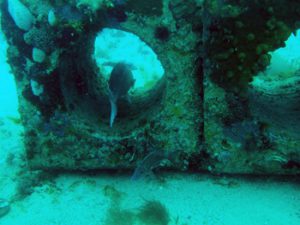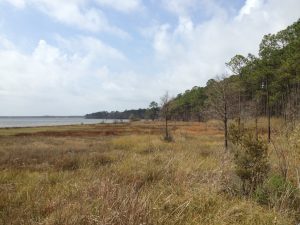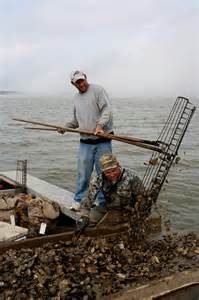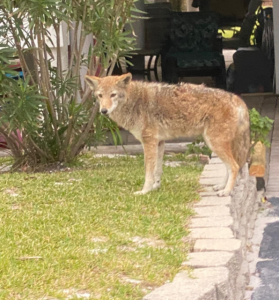Interdependence, in an ecological sense, is the dependence of living creatures on other living creatures and on their environment. No one creature can make it on its own. They rely on other species and their environment for needed nutrients, space to live and hide, access to water, and – of course – to keep their species going.

Photo: Bill Lindberg Florida Sea Grant
Each species has a set of physical, and behavioral, characteristics that allow it to obtain their needs in specific environments. Some are cosmopolitan and can do this in a wide variety of marine environments (gulls for example). Others are more endemic and can only do so within a narrow range of biological and physical parameters (seahorses for example). Some are very opportunistic and can utilize a variety of resources within the environment (raccoons for example). Others are specialist and can only survive on a specific resource, which may only exist in specific habitats (pandas for example). Either way, each is dependent on each other and their environment to continue their existence.
As you can imagine, those that are either endemic, specialist, or both are at higher risk if the environment (or the biological community) changes. Change is real. It has happened on this planet since the beginning of time. Those who can adapt will continue, those that cannot become rare or extinct. Extinction is a natural process of life on this planet. It has, and will, happen. So, you may ask “why bother trying to protect endangered species?” You would not be the first to ask this. However, in many cases the changes these creatures are experiencing are due to human activities. Some would say “We are on this planet too and should be allowed to make needed changes for our species”. But the scale of our changes is immense and many of them are not “needed” as much as they are “wanted” and there is a difference.

Another piece of this story is the need for a variety of species to exist within our environment – biodiversity. Let’s say you are a creature who feeds on grass. Your teeth are designed to do this and switching to a meat diet is not an option. Let’s say you live in a coastal marsh where there are a variety of grasses for you to select. Not all will be available due to characteristics such as the blades have silica and they cut your mouth – not going to eat it. The stems have thorns or spines – nope. The tissue produces a toxic poison – no can do. BUT there are many species of grass and you should be able to find one that is edible. However, if the variety (diversity) within the system is low – say only three species of grass to choose from – your choices now are low. If you cannot consume any of these you now have two choices (1) move to a new environment, (2) die.
Moving to a new environment may not be an option. Like the seahorse, you cannot leave the seagrass bed for the open sandy portions of Santa Rosa Sound. Seahorses are well designed to hide and hunt in the grass. They would be sitting ducks in a sandy, or even a rock jetty environment. It could a salinity issue – which many species of marine creatures have. Those who must live in a specific salinity range are called stenohaline. If coastal development forces rainwater from our neighborhoods into stormwater gutters that discharge into local waterways, this could reduce the salinity enough to impact some of the stenohaline members of the community. Maybe the salinity drops to level where the seagrasses can no longer tolerate, they die off, and thus many of the animals who depend on this grass (seahorses and scallops) decline for this reason. Runoff can also decrease the clarity of the water, which can reduce seagrass abundance, which can reduce the populations of some of the specialists. It could be increase in sediments (mud) running off after a rain which will literally bury the seagrass bed triggering the decline of community members.

Photo: Virginia Sea Grant
You might say “well there are the opportunists and the euryhaline species (those who can tolerate a wide range of salinities, like mullet) who will survive, and the system continues. Yes, this is true. I noticed after Hurricane Ivan a decline in skunks on the islands, but the number of armadillos increased. It is true that when one species declines, and their niche becomes more available, other species may benefit and step in. Many systems have experienced this form of change over time. As a marine ecologists though, you still keep your eye on the variety (diversity) within the system. If this is declining also, the entire system is at risk.
With humans we do not seem to be concerned about these changes – unless the impact us is in a negative way. The decline of scallops in the bay, or red snapper in the Gulf, is concerning. Many people enjoy harvesting these. Many businesses depend on you harvesting these. The decline of such species usually triggers research and restoration plans to turn things around. When experts sit down to begin a restoration plan you are quickly made aware of how INTERDEPENDENT all ecosystems are. To restore oyster beds in our bay will require our understanding of what environmental and biological needs oysters have. Is it salinity? Is it sediment? Have the currents changed? Is their food source gone? Are there new predators (possibly invasive species) for which they have no defense? Is it a combination? Is it one factor impacting other members of the oyster reef community that, in turn, have impacted the oysters? It is not always something impacting the oyster directly. Many times, it is a change (environmentally or biologically) that alters something within the system, which is so INTERCONNECTED with everything else that it eventually impacts the oysters – then we notice – then we take action. But what action? What is REALLY impacting the oyster decline? Life is very interconnected… very complex… and within the system everyone literally depends on everyone else.

Photo: Florida Sea Grant
We do know that there are some species that are what we call a keystone species. The corner stone of the entire community. One in which we ALL depend. The loss of a keystone species can be catastrophic in so many ways. Gopher tortoise for example. These land-dwelling turtles dig deep burrows in which no fewer than 370 other species depend for some part of their survival. The loss of gopher tortoises in the southeastern United States triggered the decline of many other species. It took time for scientists to realize the decline of others was connected to the loss of the tortoise and that without restoring the tortoise populations, other restoration efforts were a waste of time.
Here is an interesting story of how interdependent life is. Wolves in the Yellowstone area were of concern to local ranchers, for obvious reasons. The wolves were either killed to relocated to reduce the risk to their livestock. A member of the community has now been removed. An ecological niche (top predator) is now open. Knowing how interdependent all species within a community are, how will the removal of this one impact the community?
What happened… the elk populations increased due to the absence of predators. Many see this as cool – more elk to see roaming through the yards. The elk began to overgraze much of the vegetation along the stream beds. Vegetation that actually played a role in both holding the stream bed in place AND maintain good water quality. Which the trout in the stream DEPEND on. That is exactly what happened. The elk overgrazed the aspen and other plants, the stream gave way and began eroding, the water became less clear, many of the stream organisms declined, the trout declined, the entire system declined – changed. Just from removing one creature. A creature of which we did not understand its importance to the system.

Photo: Monika Springer Honeycutt
The same could be said for sharks in our waters. There has been a decline in some species of sharks, primarily from overfishing, and many see this as a good thing. Marine ecologists on the other hand see it as a concern. Do you see the concern? We could say this for snakes, wolves, bobcats, the list goes on.
Turns out oysters are not only important as a food source, oyster reefs do a lot to maintain water quality and provide habitat for a myriad of fish and invertebrates. The loss of such systems as oyster reefs, salt marshes, and seagrass can impact up to 90% of the commercially valuable marine species in the estuary.
It is said that the number one cause of species decline is loss of habitat. That loss can be natural or caused by humans (anthropogenic). There are many changes happening in our bays and oceans that have marine ecologists watching and monitoring. Rising temperatures, ocean acidification, excess stormwater runoff, invasive species, and more. Yes, there are species that will actually benefit from these changes, others will not. These changes could be widespread enough to not allow some species other options for this change. But it is the diversity of life – the variety – that has a lot of ecologists concerned. Remember our example of the grass eating animal in the marsh? What if the landscape was so devoid of diversity that there were only one or two species of plants living there, a monoculture? And what if one of those species was battling a fungus it could not defeat. That plant species’ population now declines. And you cannot eat the other species. What now?
There is SO much we could cover in this topic and SO many stories and examples we could include to teach the lesson. I hope you have a better understanding of biological interdependence and how life on our planet works.
Let’s do some activities.
ACTIVITIES
- If you can get to a shoreline, walk part of it and count how many DIFFERENT species you see. Is there one species that is more common than others? If so, can you tell why that one is more common than most? What adaptation does it have to be so successful here?
- To make it more scientific, you can start at the waterline – draw a square meter in the sand (3.4’ x 3.4’) – count how many different creatures you see within this square AND how many of each species. Determine the Species Richness (the total number of DIFFERENT species within your square). Determine the Simpson Index (the total number of one species / the total number of all organisms found). NOW walk 10 steps inland – repeat. How do the two locations compare? If there is a difference, can you explain why? Why would one location be higher than another (in your opinion)? Understand you are now entering the scientific process from our lessons on the Nature of Science and you can take this as far as you want. For one – repeat several trials (n=…) remember the more you repeat the closer you get to what the truth is. Your call on how many you want to do. You could do it systematically – do two squares, 10 steps away from each other, now walk 10 steps DOWN the beach and repeat – repeat every 10 steps down the beach – repeat as many times as you would like. Another Nature of Science piece would be to develop a logical explanation as to why one location has higher species richness (or Simpson diversity index) and then design an experiment to test this hypothesis. You may or may not be able to conduct the experiment – but the planning process is a good educational practice. Remember when designing your experiment to think of what your dependent and independent variables will be, what are you constants (and how you will keep them constant as well as how you monitoring those), and a control if you can. If you do not remember what these are, read Lesson 3 in The Nature of Science on this website. It can be fun to design such things.
FOR THE KIDS
- I would just simply walk the beach and see how many different kinds of creatures you can find. Maybe you can set a goal of finding 10 before we are done. Hermit crabs are always fun 😊
 1
1
